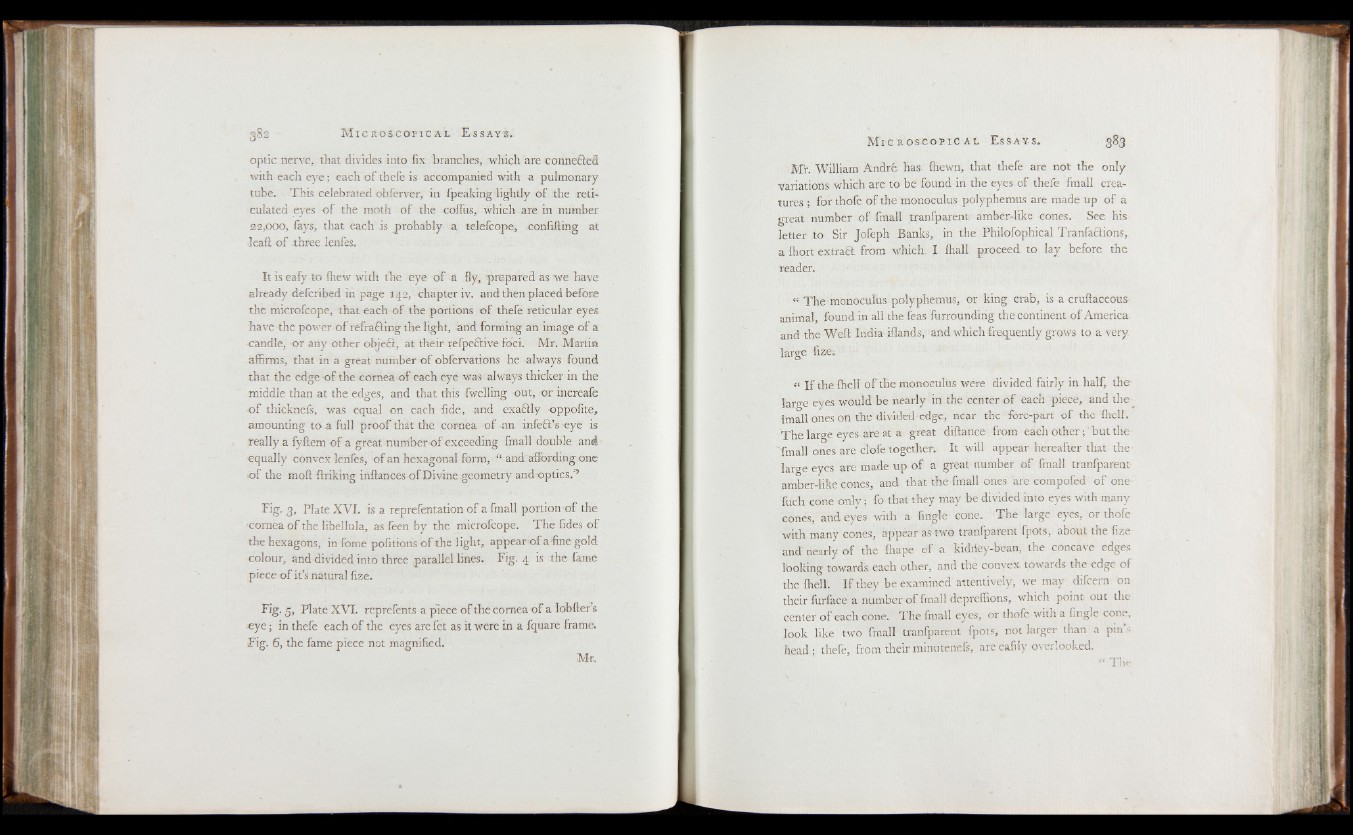
optic nerve, that divides into fix branches, which are connected
with each e y e ; each o f thefe is accompanied with a pulmonary
tube. This celebrated obferver, in fpeaking lightly of the reticulated
eyes o f the moth o f the coffus, which are in number
22,000, fays, that each is probably a telefcope, confifting at
Jeaft o f three lenfes.
It is eafy to (hew with the eye o f a fly, prepared as we have
already defcribed in page 142, chapter iv. and then placed before
the microfcope, that each o f the portions o f thefe reticular eyes
have the power o f refrafting the light, and forming an image o f a
■ candle, or any other objeft, at their refpeftive foci. Mr. Martin
affirms, that in a great number o f obfervations he always found
that the edge of the cornea o f each eye was always thicker in the
middle than at the edges, and that this fwelling out, or increafe
o f thickiiefs, was equal on each fide, and exactly oppofite,
amounting to a full proof that the cornea o f an infeft’s eye is
really a fyflem o f a great number-of exceeding fmall double and
equally convex lenfes, of an hexagonal form, “ and affording one
o f the moft {hiking inftances o f Divine geometry andoptics.’’
Fig. 3, Plate XVI. is a reprefentation of a fmall portion o f the
cornea o f the libellula, as feen by the microfcope. The fides o f
the hexagons, in fome pofitioris o f the light, appear o f a fine gold
colour, and divided into three parallel lines. Fig. 4 is the fame
piece o f it s natural fize.
Fig. 5, Plate XVI. reprefents a piece o f the cornea of a lobfter’s
-eye; in thefe each of the eyes are fet as it were in a fquare frame.
Fig. 6, the fame piece not magnified.
Mr.
Mr. William André has (hewn, that thefe are not the only
variations which are to be found in the eyes of thefe fmall creatures
; for thofe of the monoculus polyphemus are made up o f a
great number o f fmall tranfparent amber-like cones. See his
letter to Sir Jofeph Banks, in the Philofophical Tranfaflions,
a Ihort extract from which. I Ihall proceed to lay before the
reader.
« The monoculus polyphemus, or king crab, is a cruftaceous
animal, found in all the feas furrounding the continent of America
and the Weft India iflands, and which frequently grows to a very
large fize:
“ I f the ftielf o f the monoculus were d iv id ed fairly in h alf, the-
la rg e eyes w o u ld b e nearly in the center o f each p ie ce , and the-^
fmall ones on th e divided edge, near the fore-part o f the Ihell.
The large eyes, are at a great diftance from e ach o th e r ; ‘ b u t the
Trna.ll ones are c lo fe to g e th er . I t w ill ap p ear hereafter that the
la rge eyes are made u p o f a great number o f fmall tranfparent
amber-like cones, and th a t th e fmall ones are com p o fed o f one-
fu ch cone o n ly ; fo that they may b e divided into eyes with many
Gones, and e y e s with a Angle- co n e - T h e la rge eyes, o r thofe
w ith many cones, appear as two tranfparent fpots, about the fize-
and nearly o f the fliape o f a kidiiey-bean, the con ca t e edges
lo o k in g towards each other, and the convex, towards the edg e o f
the Ihell. I f th ey b e examined a tten tive ly , we may difcern on
their furface a number o f fmall depreffions, which point out the
center o f each cone. T h e fmall e yes, or thofe with a Angle cone,
lo o k lik e tw o fmall tranfparent fp o ts , no t la rg e r than a pin s
head ; thefe, from their minutenefs, are eafily o v er lo o k ed.
11